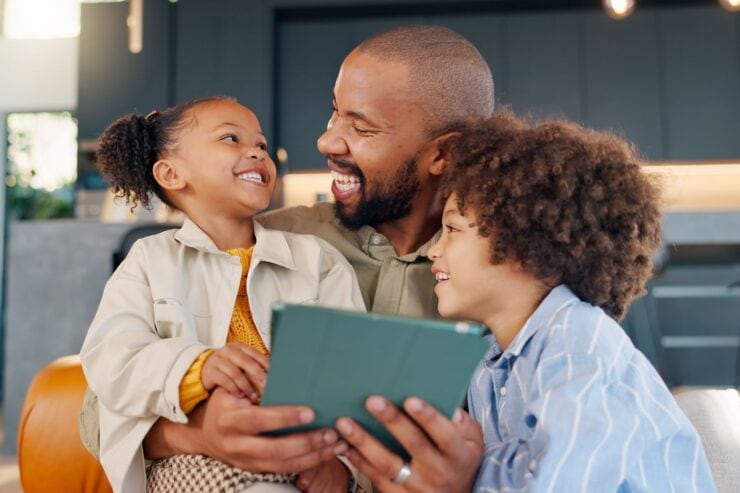How to create joyful connections with children
Joyful talk and play in everyday scenarios help children learn

Perhaps you’ve experienced the joy of transforming an everyday interaction into a moment of discovery for a young child. Bringing joy into making dinner, riding the bus, or picking an outfit together probably made you both smile, and brightened your day.
Such joyful moments also enhance children’s learning. They create powerful memories and associations that can serve as the foundation for future learning. Mutual joy shared with caring adults becomes a powerful motivator for babies, inspiring them to learn new ways to keep that joyful connection going. Joyful moments also foster the caring, safe, and reciprocal relationships in which learning happens best.
“Joyful moments also foster the caring, safe, and reciprocal relationships in which learning happens best.”
Joy is often thought of as synonymous with happiness, and as a lucky offshoot of external circumstances that are sometimes beyond our control. The reality, however, is that joy is a deeper, more complex emotion that arises from within and can be intentionally cultivated. And the benefits are often far-reaching. Feelings of joy engage the brain’s reward system, triggering a constellation of other positive emotions that enhance the cognitive processes necessary for remembering, reasoning, and making good decisions.
At the same time, joy strengthens social bonds by encouraging the sharing of talk, play, and feelings that promote empathy, communication, and collaboration. Responding even to our mistakes with joy may reduce anxiety, build resilience, and fuel creativity.
Bringing joyful learning to families
We wanted to know whether we could teach adults to engage in joyful talk and play at home as a way of fostering children’s (and parent’s) everyday learning.
Twenty-six families participated in our pilot study. All participants received a children’s book and an overview of key learning-science concepts to take home, which also included practical examples of early math. Families were assigned to one of two different rooms, depending on the amount of time they had to spare.
The first group participated in a 1-hour, facilitator-led session that included interactive reading. Participants were given concrete examples of possible ways to read and act out each page of the book and apply its lessons in everyday situations. Activities explicitly incorporated evidence-based learning strategies such as gazing into a baby’s eyes, mindful breathing, and dialogic reading. The session started with music and ended with a brief shared meal. The second group took part in a half-hour self-directed session, in which families read the book on their own and tried to put some of the suggested examples into practice.
The explosion of play and laughter that resulted from these experiences would have been reward enough. But we also came away with some key early lessons from the surveys parents subsequently completed. Parents who reported having learned about the science of joyful learning felt more confident to continue using the provided resources at home. We also found that early math instruction through “math talk,” like counting together or comparing fingers and hands, was enjoyable for parents and children in both groups, suggesting that what matters most are parents’ efforts to create joyful learning moments.
Perhaps most importantly, the intention to create joy mattered more than the quality or attractiveness of the learning resources. Joyful learning happens when people come together; it’s not something one person gives to another. Notably, there was no difference in the level of joy reported by the two groups, suggesting that even brief, intentional moments of joyful learning can be impactful. Parents in both groups found math talk more engaging when it was integrated into joyful interactions, which reinforces the idea that the quality of engagement matters more than the specific materials provided. However, the two groups were not alike in every respect: Parents in the first group reported a stronger sense of connection with their child and greater confidence in applying learning-science strategies at home. It appears that practical examples make it easier for parents to translate the content into practice.
“Joyful learning happens when people come together; it’s not something one person gives to another.”
Our findings are early and based on a small sample, so follow-up research is needed. Joyful learning is an outcome of mutual joy and shared positive emotions experienced by infants and caregivers. If parents and caregivers who receive well-crafted messages about the science of joyful learning are better able to create joyful connections with their children, then we should try to make that happen for as many people as possible. Our goal is to equip adults with the tools they need to recognize and create these moments. By engaging in playful conversations and joyful routines, parents and caregivers can not only build language and learning, but also promote healing, confidence, and long-term resilience.
How to facilitate joyful learning at home
Our project and findings helped us identify a few practical ways in which parents and caregivers can bring learning science to life in their everyday routines. These tips are easy to put into practice—and rooted in powerful research about how joy fuels learning.
1. Make conversation a playful game
Turn everyday moments into playful back-and-forth talk. Ask silly questions, invent stories together, or narrate the adventure of carrying out daily tasks. When you and your child look into each other’s eyes and take turns talking, it builds connection and strengthens your child’s thinking skills.
Why it works: Joyful interactions activate the brain’s reward system, improving memory, reasoning, and focus. Playful conversations cultivate joy—even during difficult days.
2. Discover math learning in little comparisons
Count snacks, sort socks, or look to see whose arms are longer. Use everyday math words like more, under, heavier, or the same. These playful, descriptive moments help your child make sense of the world.
Why it works: Joint rituals—like sorting or counting together—foster connection, collaboration, and early problem-solving. They show children that learning is social, joyful, and something we do together.
3. Find the spark in the small stuff
Take a deep breath together. Share a giggle. Hug after a long day. These micro-moments of connection build emotional safety and make learning stick.
Why it works: Joy isn’t just a response to something positive—it’s something we can practice. Even when things are hard, choosing to pause and connect can lower stress, boost empathy, and unlock creativity in both kids and adults.
Footnotes
These are the key findings of a two-year, cross-disciplinary project sponsored by the Learning Sciences Exchange at New America, a Washington, D.C.-based think tank. A neuroscientist, a community family-literacy specialist, a children’s book author, a social entrepreneur, and a journalist spent two years together developing a strategy for raising public awareness about the science of joyful learning. Our aim was to help parents and caregivers of young children cultivate more of these gentle but powerful moments. The result was Joy Lives Here, a set of resources and experiential learning opportunities based on cutting-edge learning science. In September 2024, the Joy Lives Here team partnered with Play Smart Literacy to conduct the pilot study described above with 26 families in Chicago.
One comment
Comments are closed.



follow-up information would be appreciated. This resonates with what I have been writing, although I address it from a different perspective. I would be interested in additional resources based in neuroscientific research and how these positive experiences foster positive influence on the DNA molecules of our children.